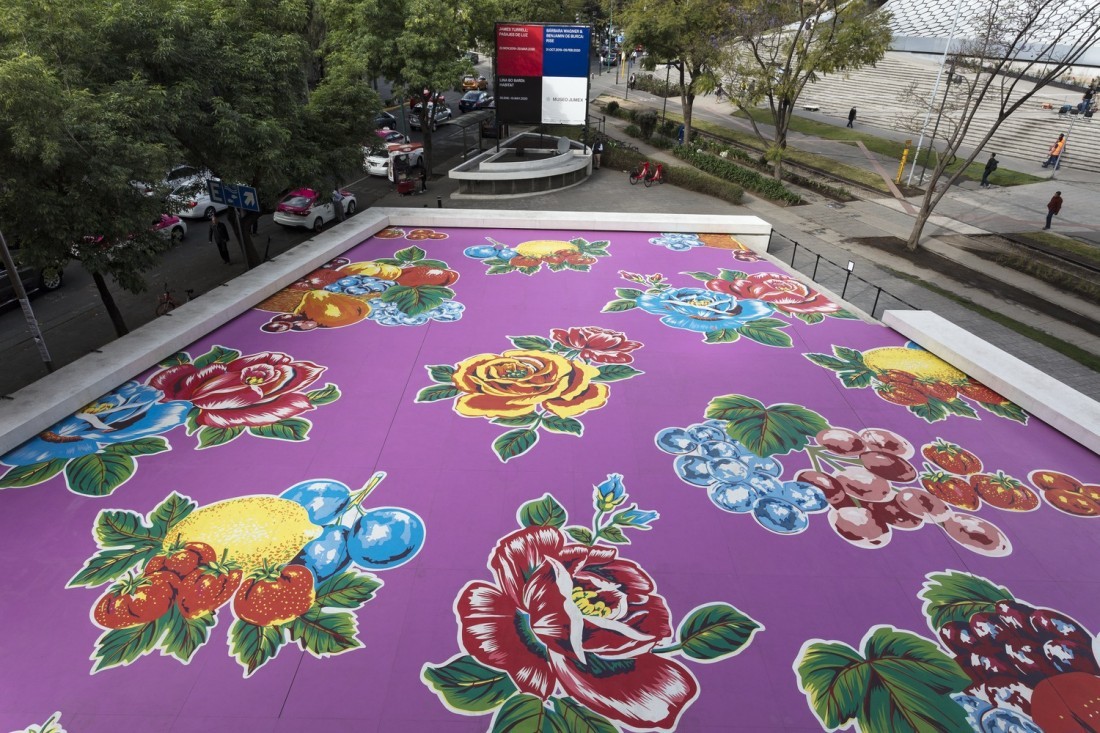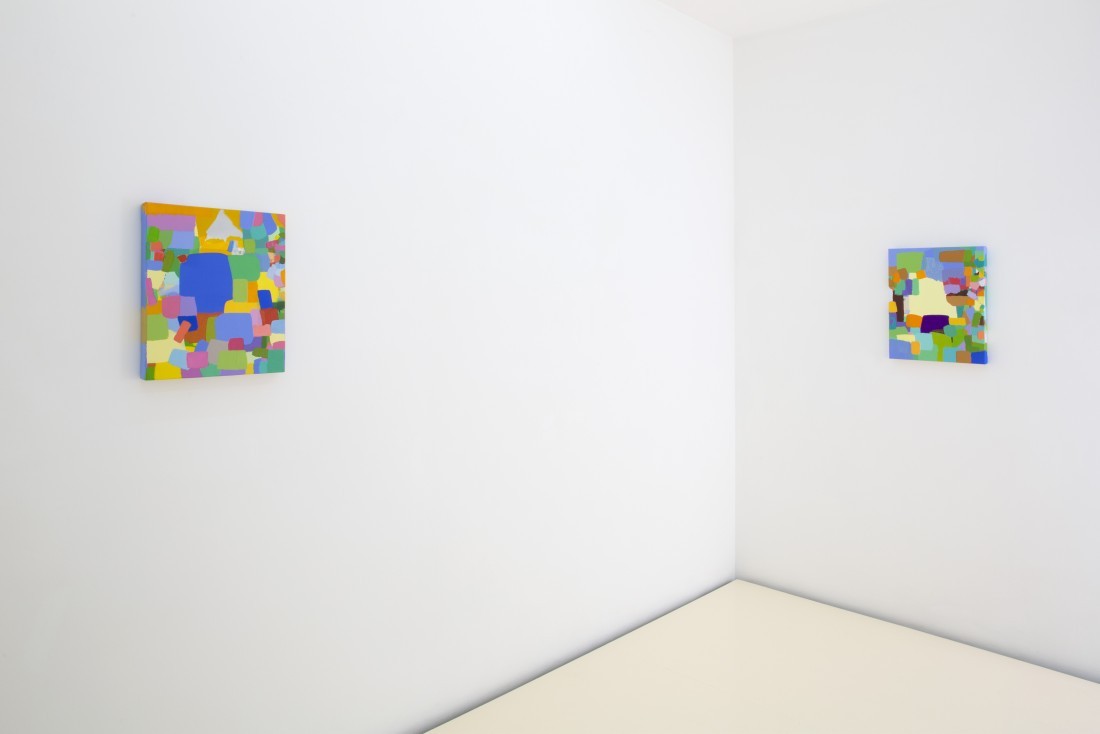Michael Lin and Federico Herrero
Michael Lin’s temporary commission for the private art foundation Museo Jumex is a hand-painted floor that occupies 1,300 square metres across the museum’s plaza and through the building’s main level. The work is based on a traditional tablecloth design, one found in inexpensive restaurants in Mexico and one that echoes textile designs from Lin’s native Taiwan. The show’s title, “Mariposa B1-09,” is the name of the commercial paint, a vibrantly alarming pink/violet concoction, used for the background of the work. The floor was painted by a team of sign painters under Lin’s direction. The painting acts as a physical and metaphorical stage on which the interplay of popular culture with art and its institutions is presented. Lin brings our attention to the spaces within the museum that might be regarded as “peripheral”; his painted floor extends through the café and the bookshop, complicating the demarcation between the “approach” (bag check, tickets, coffee) and the institutional viewing space itself (currently occupied by James Turrell). To be clear, the painting massively enlarges the pattern, a café table for six easily accommodated across the circumference of a giant graphically painted rose.

Michael Lin, installation view, “Mariposa B1-09,” Museo Jumex, Mexico City. Photo: Abigail Enzaldo.
Across town, another painter who has frequently taken his work out of the studio, Federico Herrero, has resisted that strategy here and is showing six small paintings at the project space Lulu. Among many extra-gallery projects, Herrero has used coloured adhesive vinyl up and down Nelson Street in Vancouver and has painted across a children’s playground on the Pelican Estate in South London. The single concession to the creation of an environment for Herrero’s work here is the painting of the floors in the two rooms Lulu occupies. Both are painted in quintessential Herrero colours, one a light Naples Yellow, the other sky blue. Those colours recur in the six paintings, four of which feature what one might call the “Herrero composition,” a loose grid of irregular patches of flat, pastel- based oil and acrylic paint. It’s a technique that can scale up to any size, apparently, and one that sits as well on asphalt as on canvas. Mostly, at Lulu, they’re laptop size, a surprising intimacy for an artist who has often shown similar scalar predilections to Michael Lin’s “Mariposa B1-09.” Herrero’s work is often described as referring to urban design—the layout of cities like those of his native Costa Rica (and like Mexico City), where colonial architecture collides with later layering of modernist and contemporary additions to buildings. The composition of his paintings, then, provides an ambiguous viewing experience— one making both elevation and plan available simultaneously in an abstracted version of sunlit sprawl.
For both of these projects, Lin’s floor at Jumex and Herrero’s studio works, colour is the primary experience for the viewer. As we have seen, Lin appropriates his palette from the vinyl tablecloths of a fonda or taqueria—saturated hues that directly sample a palette from this vernacular design source of stylized floral patterns. To do this he and his assistants have employed 21 commercial paints. Lin has provided a colour chart on the wall adjacent to the plaza, a swatch of each of the 21. They’re named with an accompanying identifying code. So we find CAHUN F1-13, FENICIO Q3-13 and BOMBERO E1-14. It’s a gesture that announces the prosaic commercial/industrial nature of the material used in his installation. The named and numbered trade products from the hardware store are relocated to the high art venue that is Jumex. Their inclusion here brings to mind curator and writer James Meyer’s distinction between literal and functional space for non-studio painting, the functional site offering an opportunity for a mapping of institutional and textual filiations. By painting this appropriated design here, Lin interrogates the function of the space itself.

Federico Herrero, installation view, Lulu, Mexico City.
At Lulu, Herrero’s colours cross-over with Lin’s. In his painting Montana, we see hues very like NUBE Q2-08, a light ultramarine, and the cerulean ARRECIFE Q1-09. HOMERO J1-11, a golden yellow, is close to a particularly characteristic Herrero mix that is present in an untitled 2020 painting in this show. Differentiation between the two artists’ work occurs when Herrero employs tints that depend on the addition of white—and he frequently does; those colours produce bright pastel shades that seem to stand for sky, vegetation and architecture seen under strong sunlight. Lin’s quotation comes from the study of an artifact, the tablecloth; Herrero’s observational derivation comes from the study of light, seen, perhaps, as the edge where an urban park meets the walls of the barrio. These are contrasting ways to conceive of colour in works of art: a way of working through quotation and a way of working through observation. It’s one of the differences that enrich the comparative viewing experience of these shows that run simultaneously, two exhibitions that share an exuberant attitude to colour as it figures into a contemplation and consideration of urban life.
The dates of the opening of the two exhibitions explain that exuberance. Pre-pandemic painting, particularly when its subject is, in one way or another, spaces in cities, may come to look as distant as work made in the chilly light of utopian modernism. These two shows magnify that possibility—they are installed a few kilometres apart in a city where social distancing is the preserve, on the very best of days, of a small, privileged social class. Both shows suggest to the viewer kinds of compression in the ways they deal with the spaces we observe and inhabit: the density of Herrero’s stacked patches, the inescapable nature of Lin’s floor once the viewer is on the property. These differing treatments of space seem keenly observed in a congested mega-city. Since the two shows opened, that sense of density, of crowding, has altered from a feeling of excitement in the hum and possibility of the city to something that reminds us that such proximity has become a matter of life and death.
Michael Lin, “Mariposa B1-09,” was exhibited at Fundación Jumex, Mexico City, from February 4 to June 28, 2020.
“Federico Herrero” was exhibited at Lulu, Mexico City, from February 4 to April 4, 2020.
Martin Pearce is a painter and the director of the School of Fine Art and Music at the University of Guelph.

